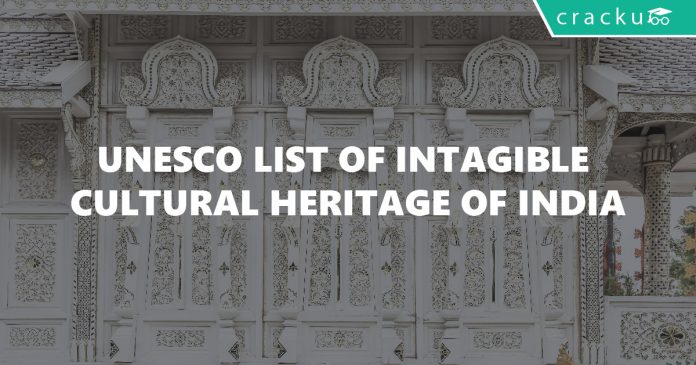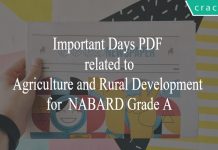General Awareness requires knowledge on many different subjects, one such subject is UNESCO World Heritage Sites and Elements in India. In Banking and other competitive exams like RRB, CDS, LIC AO, RBI, SSC, UPSC, FCI, UIIC, OICL, SBI Clerks and PO the questions on UNESCO reconised Heitage sites and elements are being asked. Please check out Some of the Banking Previous Papers for the same. List of UNESCO World Heritage Sites in India PDF gives the list of intangible cultural heritages elements of India recognized by UNESCO. UNESCO (United Nations Educational, Scientific and Cultural Organization) has approved 12 elements in India. One element Nowruz/Navroz (New Year Festival) is commonly observed in many countries in Asia including India. Please go through the below list of UNESCO Intangible Cultural Heritage Elements of India. You can also download the same information in the PDF format. Take a Free SBI Clerk Test. Also please utilize 100 free GK Tests and 100 free Computer Awareness Tests to improve your knowledge in both of these areas. These free tests on GK and Computer awareness will be available for free for a limited time period.
Download General Science Study Material PDF
Download Important Loan Agreements in 2018 PDF
[icegram campaigns=”7908″]
List of Unesco Intangible Cultural elements PDF
Get 75 IBPS Clerk Mocks for just Rs. 199
Download SSC CGL detailed syllabus PDF
| Element | Comments |
| Kutiyattam ,
Sanskrit theatre (2008) |
It is an Oldest & Sanskrit theatre play reflects the local traditions of Kerala, India. The art is focused on detail and elaboration. Thus a single act may take days and a performance may last up to 40 days. |
| Tradition of Vedic chanting (2008) |
The traditional way of reciting the Vedas is called Vedic chanting. They comprise of Hindu philosophy, myth, poetry and dialogue. There are four Vedas – Rig, Yajur, Sama and Atharva. The Vedas were originally written in Vedic Sanskrit, later translated to Classical Sanskrit. |
| Ramlila, the traditional performance of the Ramayana (2008) | Ramlila is the dramatic folk re-enactment of the life of Rama enacted in a theatrical form. It is traditionally performed in northern India during the Sharad Navratras. Most Ramlilas are based on the Awadhi version of Ramayan called the “Ramcharitmanas” composed by Tulsidas. |
| Ramman, religious festival and ritual theatre of the Garhwal Himalayas (2009) | It is a festival of the Hindu community in honour of the tutelary god, Bhumiyal Devta, a local divinity in the Saloor Dungra village of the Painkhanda Valley in the Chamoli district in Uttarakhand, India. This event is made up of highly complex rituals: the recitation of a version of the epic of Rama and various legends, and the performance of songs and masked dances. |
| Mudiyettu, ritual theatre and dance drama of Kerala (2010) | It is a traditional ritual theatre and folk dance drama of mythological tale of a battle between the goddess Kali and the demon Darika. The ritual is a part of the Bhagwati cult. It is performed in just 4 districts of Kerala during the four day festival dedicated to Goddess Kali after the summer harvest. |
| Kalbelia folk songs and dances of Rajasthan (2010) | Kalbelia or Kabeliya is one of the most sensuous dance forms of Rajasthan, performed by a tribe of the same name which mimics the movements of snakes in some sense and was usually performed on joyous occasions. Kalbelia songs disseminate mythological knowledge through stories, while special traditional dances are performed during Holi, the festival of colours. |
| Chhau dance (2010) | Chhau dance also called the Paiku nratya (battle dance) is a semi classical Indian dance with martial, tribal and folk origins prevalent in the states of Odisha, Jharkhand and West Bengal. It has three sub genres based on location and is mainly performed during a regional festival, especially during the Chaitra parva, where they perform it in honor of the Cosmic God Shiva, known for his dance form Tandava. |
| Buddhist Chanting of Ladakh – Recitation of sacred Buddhist texts in the trans-Himalayan Ladakh region, Jammu and Kashmir (2012) | In the monasteries and villages of the Ladakh region, Buddhist lamas (priests) chant sacred texts representing the spirit, philosophy and teachings of the Buddha. Two forms of Buddhism are practised in Ladakh – Mahayana and Vajrayana. The lamas make hand gestures with each chant to represent what Buddha preached. |
| Sankirtana, ritual singing, drumming and dancing of Manipur (2013) | It is performed in the temples and domestic spaces in Manipur State in India. Through the performances which exhibit unparalleled religious devotion and energy, the performers narrate the many stories of Krishna. It was started by the Manipuri Hindus in the 15th century in the belief that in Kaliyuga the Punya (Merit) and Moksha (transcendence) is achievable through Sankirtan. |
| Traditional brass and copper craft of utensil making among the Thatheras of Jandiala Guru, Punjab (2014) | It constitutes the traditional brass and copper making technique of utensils in Punjab. The Group of people who have kept the art alive and still practice it till date are called “Thantheras” and the process of manufacturing is transmitted orally from father to son. They primarily use copper, brass and kansa (an alloy of copper, ton and zinc). Eating and Cooking in these metals is recommended by Ayurveda. |
| Nowruz/Navroz (2016) | March 21 marks the start of the year in Afghanistan, Azerbaijan, India, Iran (Islamic Republic of), Iraq, Kazakhstan, Kyrgyzstan, Pakistan, Tajikistan, Turkey, Turkmenistan and Uzbekistan. In India, the Parsi community, who follow Zoroastrianism, celebrate Navroz. A variety of rituals, ceremonies and other cultural events take place for a period of about two weeks. The festival symbolizes cultural diversity and tolerance and contribute to building community solidarity and peace. |
| Yoga (2016) | Yoga is a group of physical, mental, and spiritual practices or disciplines originated in ancient India. It consists of a series of poses, meditation, controlled breathing, word chanting. There are broad variety of yoga practices, among the most well-known types of yoga are Hatha yoga and Raja yoga. Traditionally, yoga was transmitted using the Guru-Shishya model (master-pupil) with yoga gurus as the main custodians of associated knowledge and skills. |
Please spread a word about us with your friends. Thank you for visiting our blog. Cracku is the best site to prepare for several competitive examinations. Please Subscribe to this blog. Please review us by rating and let us know how we are doing by commenting. Also take a look at other GK topics by clicking the link below.
Download GK Questions with Answers PDF





